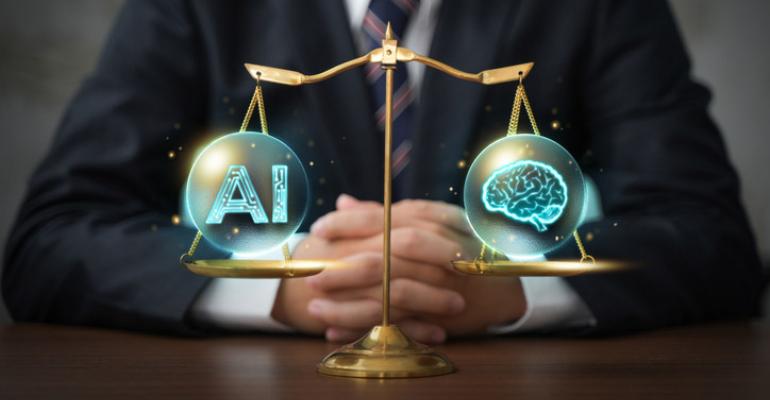Warning: Please note that the generated output is not legal advice. You are advised to consult a lawyer.
That’s the small print on the legal prompts in Spark, the meetings-specific generative-A.I. engine launched earlier this year by the Professional Convention Management Association and Gevme, an event-technology provider. According to one meetings-industry attorney, that’s a warning well worth heeding.
Overall, Spark is an impressive A.I. tool, with built-in prompts designed specifically to help planners in a number of surprising ways, including analyzing session feedback, brainstorming event themes, writing press releases and LinkedIn posts, and creating attendee polls. (Read more of our Spark coverage here.) However, according to Joshua Grimes, Esq., of Grimes Law Offices, LLC, the legal contracts section of the Spark platform should be approached with care.
In that section, users have three options: They can ask Spark to review a clause, generate a clause, or review an entire contract. When asked to generate a clause, for example, users must note the type of contract, the kind of clause, and the jurisdiction of the contract. They can also include the purpose of the clause, the parties involved, specific terms, and confidentiality requirements.
Grimes spent some time testing the platform and found that the clauses generated didn’t always align with industry norms. For example, he asked the system for an overbooking clause for a group hotel contract. His assessment: “The overbooking provision did not require the hotel to find replacement accommodations, nor did it call for the hotel to pay for each walked guest’s room, or to transport walked guests from their substitute lodging to the meeting hotel. It only required the hotel to pay the group’s additional costs incurred as a result of the overbooking—which could be nothing at all.”
“By contrast, industry-standard hotel-contract clauses obligate the hotel to pay for each walked guest’s room every night the guest cannot be accommodated at the hotel and is relocated, and also for reasonable transportation costs and certain other expenses. And Spark’s provision gives the group the express right to approve the substitute hotel, which is also unusual.”
Another example concerned attrition clauses. “The first clause I generated had the group paying 100 percent of the room rate for each room left empty—not a percentage of that room rate as lost profits, which groups typically prefer as a measure of damages,” said Grimes. “But then, when I re-ran the clause after adding the term ‘liquidated damages,’ Spark awarded the hotel attrition damages equal to only 80 percent of the total anticipated revenue—and Spark also included a duty for the hotel to resell unused rooms and provide the group with credit against damages for those resold rooms. Under the law in most jurisdictions, there’s no obligation for a hotel to offer a credit for rebooked rooms when ‘liquidated damages’ apply. So the attrition clauses generated by Spark can become more favorable for one party or another just by changing one term.”
The lesson, says Grimes, “is that Spark is helpful in giving the user an idea of contract clauses, but it cannot be relied upon to generate provisions that will best meet either a hotel or a group’s interests, or legal requirements. Contracting experts and experienced professionals are still essential to arrive at an equitable contract.”
Bruce MacMillan, PCMA’s chief operating officer, is in full agreement. Citing Spark’s admonition regarding its legal output, he says: “It’s a warning, not a suggestion.”
MacMillan notes that “being informed is probably the most important thing when you're using A.I. The [legal section of Spark] is not meant to replace legal advice; it’s meant to accelerate the business process around the development of a contract.” He points to Spark’s “review contract” section, which includes a drop-down menu of ways the system can approach its analysis. Choices include “areas of concern,” “risk assessment,” “recommendations for revisions,” and others. The Spark contract review, MacMillan says, can be helpful in pointing out problematic clauses thus speeding up the work of the organization’s lawyers.
While unrelated to the accuracy of contract clauses, MacMillan also noted Spark’s ISO compliance around data handling and privacy: Contracts and clauses uploaded into the system for review are not shared. Once a user concludes a session, the cache is cleared.
Compared to writing social-media posts or brainstorming ideas for conference themes, developing contracts is a high-stakes task. A recent Thompson Reuters article on A.I. and legal work includes the results of a survey in which 82 percent of legal professionals say A.I. can be applied to legal work—but at this point just 52 percent think it should be. Nevertheless, the article concludes that the coming of A.I. to legal work is “a given.” What A.I. systems lack in nuanced legal judgement, creativity, and niche-industry knowledge is where the lawyers come in.
“Regardless of what A.I. generates, it needs human eyes on it to ensure that what has been created is accurate and pertinent to the prompt,” the article states. “In the same way an attorney would oversee the work of an entry-level employee, monitoring and managing A.I. is a good business practice. This oversight plays a crucial role in minimizing risks, maintaining control, and harnessing the benefits of A.I. in a responsible manner.”
Grimes echoes that sentiment. “It's not necessarily that Spark is good or Spark is bad; rather, it's about understanding what Spark can and can't do, and how human expertise is still required.”
READ HOW PLANNERS ARE USING A.I. IN THEIR WORK





